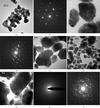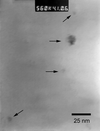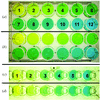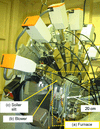issue contents
October 2005 issue

Cover illustration: Secondary electron image of a crystalline iron ore sinter phase, produced by heating to 1533 K and then cooling. Courtesy of N. V. Y. Scarlett, I. C. Madsen, M. I. Pownceby & A. N. Christensen [J. Appl. Cryst. (2004), 37, 362-368].
research papers
The indium mass absorption coefficient for an X-ray energy of 8.047 keV has been experimentally determined with an accuracy of 1%. The value was compared with previous experimental and recent theoretical values.
The paper introduces a correlation function of the excluded volume necessary for a real-space description of scattering from dense systems of spherical particles.
The paper presents (spin-echo) SANS correlation functions describing small-angle scattering on dense systems of spherical particles. (Spin-echo) small-angle correlation functions and associated correlation lengths for a single sphere, a dumbbell, excluded volume and structure are introduced.
The phase relations and equation of state of ZrO2 were investigated up to 100 GPa by means of in situ observation using laser heating in a diamond anvil cell and synchrotron radiation. In situ high-temperature experiments performed below 12.5 GPa suggest the possibility that stoichiometric ZrO2 does not show the cubic structure up to the melting temperature.
The in situ vapor sorption technique is used to overcome the fundamental limitation of negligible neutron scattering contrast in semicrystalline polymers and to demonstrate that vapor selectively diffuses into the amorphous phase.
p- and n-type silicon samples containing a one-dimensional periodic array of buried empty channels were characterized by high-resolution X-ray diffraction. The crystal quality of the surface silicon layer and the layer containing the channels is much better in p- than in n-type samples, the former exhibiting Fraunhofer diffraction when the channels are normal to the scattering plane.
The polygonization of 200 nm rutile crystals during dry ball-milling was monitored by means of transmission electron microscopy, X-ray diffraction and pycnometrical density measurements. A modified Williamson–Hall evaluation was used; in addition, macrostrain was also measured.
Rietveld-quality micro X-ray diffraction (µXRD) data can be collected from the Bruker D8 DISCOVER diffractometer, provided that the diffraction conditions are selected carefully.
The automatic space-group determination procedure in EXPO2004 has been improved.
The crystalline perfection of lithium niobate single crystals has been improved by post-growth thermal annealing with slow heating and cooling rates. The effect of annealing has been tested by high-resolution X-ray diffractometry and Fourier transform infrared (FT–IR) spectroscopy.
The atomic scale structure and the local structural disorder in nanocrystalline MgFe2O4 prepared by high-energy ball milling are determined using the Rietveld and the pair distribution function (PDF) techniques.
The feasibility of obtaining a data set of X-ray structure factor amplitudes from a measured pseudo-Kossel line pattern is demonstrated.
Small-angle X-ray scattering is used to determine simultaneously the particle size distribution and the size dependence of the particle composition.
A Fourier method to connect segmented intensity data measured with a multiple-detector system for powder diffractometry has been developed. The method enables the correction of the differences in instrumental functions of different detectors.
The Edgeworth series model for the modification of diffraction peak shapes because of axial divergence is compared with the peak shapes computed by a numerical convolution method. It is shown that if the width of an approximately Gaussian instrumental peak shape is comparable with the width of the modifying function, the Edgeworth model is nearly identical to the convolution model, while the computation is much simpler.
Open  access
access
 access
accessAn analytic technique for calculating real six-dimensional rotational–translational correlations is described. The technique is demonstrated by superposing the steric shapes of a pair of globular protein domains.
Open  access
access
 access
accessAn application of e-science methodology using grid middleware networking technology to enable increased user interaction and participation with the UK EPSRC National Crystallography Service (NCS) is presented. This supports the crystallographic experiment through to the dissemination and further data use for e.g molecular property prediction. The viability of these interactions is assessed and future directions suggested.
short communications
Accurate charge density data were measured `in-house' in less than a day for pentaerythritol using a Rigaku R-Axis Rapid diffractometer with a curved image plate at 15 K.
A numerical model for converting the shapes between the Pearson VII, pseudo-Voigt and Voigt functions is derived. As a result, features of the Voigt function can be applied to the Pearson VII and pseudo-Voigt functions.
computer programs
Open  access
access
 access
accessdSNAP is a computer program for automatically classifying and visualizing the results of database searches using the Cambridge Structural Database where an exhaustive table of geometries has been obtained.
DS5, for the crystal structure analysis of small molecules on personal computers, is a new program that integrates more than 18 main programs, subroutines and mathematics/graphic libraries of the DS*SYSTEM4 package.
laboratory notes
A method for the rapid preparation of custom grid-screen crystallization trays using standardized pipetting maps is presented.
An in situ battery cell based on a Swagelok junction for high-resolution X-ray diffraction is presented. The cell works in transmission mode with sample oscillation, allows fast data acquisition and is easy to assemble.
A compact furnace has been designed and fabricated for measurements of high-resolution synchrotron radiation powder diffraction profiles from materials at high temperatures up to 1807 K in air, suitable for the multiple-detector system installed at the BL-4B2 experimental station of the Photon Factory in Tsukuba, Japan.
computer program abstracts
Raptor3D, which interactively maps functional annotations provided by biological databases onto a graphical representation of a crystal structure, is described.


 journal menu
journal menu











































